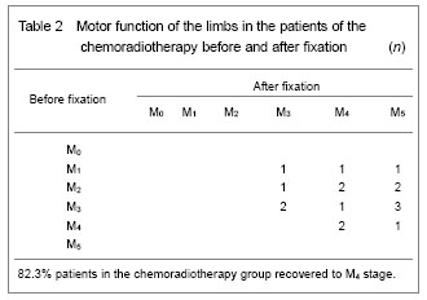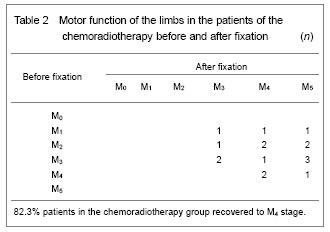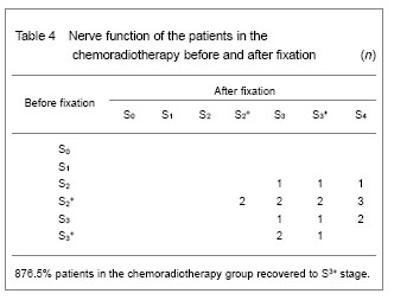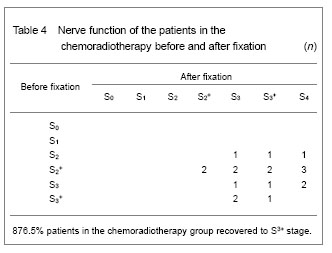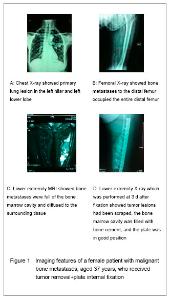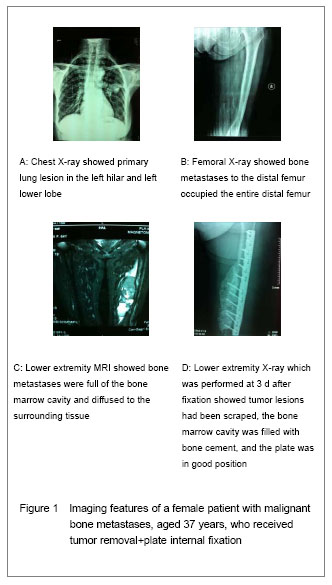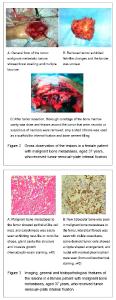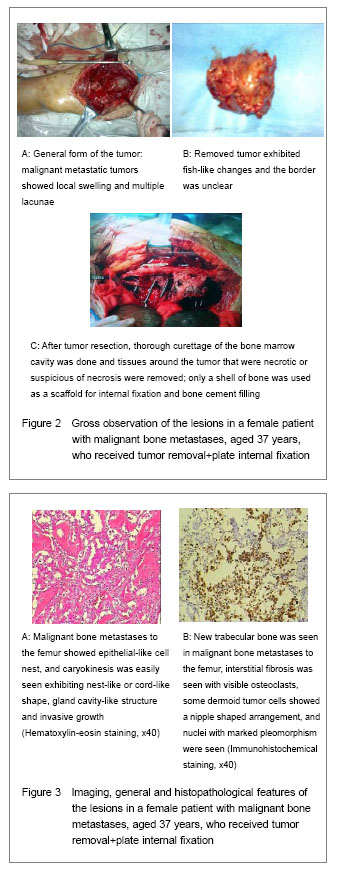Chinese Journal of Tissue Engineering Research ›› 2013, Vol. 17 ›› Issue (34): 6073-6082.doi: 10.3969/j.issn.2095-4344.2013.34.003
Previous Articles Next Articles
Combination of bone cement filling and plate internal fixation with limb salvage is used for metastatic malignant bone tumors
Yang Jun 1, 2, Yu Bin1, Guo Xin-hui2, Yang Peng3, Zhang Kai-rui1, Zhang Sheng1, Cai Wei-bin2, Ku Jian-bin2, Tian Ling-yan2
- 1 Department of Traumatic Orthopedics, Nanfang Hospital of Southern Medical University, Guangzhou 510515, Guangdong Province, China
2 Department of Orthopedics, the 421 Hospital of Chinese PLA, Guangzhou 510318, Guangdong Province, China
3 Second Affiliated Hospital of Inner Mongolia Medical University, Hohhot 010030, Inner Mongolia Autonomous Region, China
-
Online:2013-08-20Published:2013-08-20 -
Contact:Guo Xin-hui, M.D., Associate chief physician, Department of Orthopedics, the 421 Hospital of Chinese PLA, Guangzhou 510318, Guangdong Province, China guoxh421@163.com -
About author:Yang Jun☆, Studying for doctorate, Attending physician, Department of Traumatic Orthopedics, Nanfang Hospital of Southern Medical University, Guangzhou 510515, Guangdong Province, China; Department of Orthopedics, the 421 Hospital of Chinese PLA, Guangzhou 510318, Guangdong Province, China yangjun1267@sina.com
CLC Number:
Cite this article
Yang Jun, Yu Bin, Guo Xin-hui, Yang Peng, Zhang Kai-rui, Zhang Sheng, Cai Wei-bin, Ku Jian-bin, Tian Ling-yan. Combination of bone cement filling and plate internal fixation with limb salvage is used for metastatic malignant bone tumors[J]. Chinese Journal of Tissue Engineering Research, 2013, 17(34): 6073-6082.
share this article
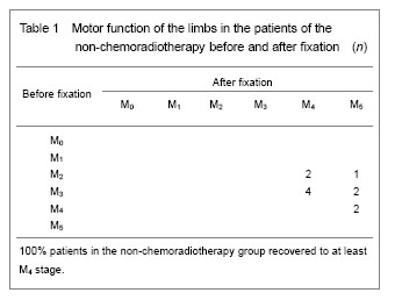
Quantitative analysis of participants Except three cases in the chemoradiotherapy group died of tumor metastasis, their poor conditions and complications at 9 and 13 months after internal fixation, the 28 patients were included in the follow-up and result analysis. Baseline analysis of participants In the present study, the mean age of the 31 patients was 42.5 years. There was no difference in the mean age between the non-chemoradiotherapy group (averagely 37.5 years) and chemoradiotherapy group (averagely 43.5 years; P > 0.05). Therapeutic efficacy of bone cement filling plus internal fixation with limb salvage on metastatic malignant bone tumors (Tables 1-4)"
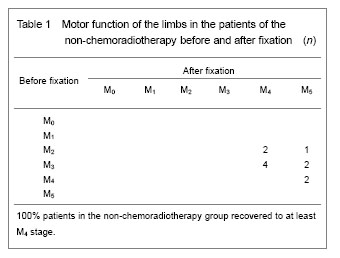
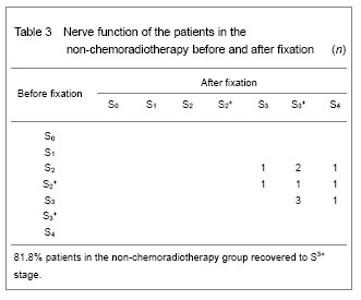
The 28 patients were followed 9-12 months after internal fixation, with a mean period of 10.4 months. Most of the patients had significant improvement in the quality of life with the help of nutrition and symptomatic and supportive therapies: digestive ability and appetite were strengthened, limb pain and other symptoms were relieved or disappeared, the patient's psychological qualities were improved significantly, personal living skills were greatly improved, and patients felt more confident in life. The grading of limb muscles and nerve function in the non-chemoradiotherapy was slightly better than that in the chemoradiotherapy after treatment. The percentage of patients whose motor function recovered to M4 stage at least was higher in the non- chemoradiotherapy group than the chemoradiotherapy group (χ2=1.45, P < 0.05; Tables 1, 2). The percentage of patients whose nerve function recovered to S3+ stage at least was higher in the non- chemoradiotherapy group than the chemoradiotherapy group (χ2= 1.02, P < 0.05; Tables 3, 4)."
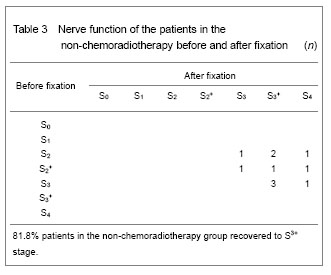
| [1]Xu ST, Ge BF, Xu YK. Shiyong Gukexue, 3rd. Beijing: People’s Military Publishing House. 2006.[2]Rougraff BT, Kneisel JS, Simon MA, et al. Skeletal metastases of nknown origin: a prospective study of a diagnostic strategy. Bone Joint Surg Am. 1993;75(9): 1276-1281.[3]Mankin HJ, Lange TA, Spanier SS, et al. The hazards of biopsy in patients with malignant primary bone and soft tissue tumors. J Bone Joint Surg Am. 1982;64(8): 1121- 1127.[4]Coleman RE. Skeletal complications of malignancy. Cancer. 1997;80(8 Suppl):1588-1594.[5]Wedin R, Bauer HC, Wersall P. Failures after operation for skeletal metastatic lesions of long bones. Clin Orthop Relat Res. 1999;(358):128-139.[6]Deng ZC, Chen ZG, Zahng TH, et al. Clinical analysis of the pathological fracture in femur. Zhongguo Zonghe Linchuang. 2000;16(11):828-829.[7]Salmon JM, Kilpatrick SE. Pathology of skeletal metastases. Orthop Clin North Am. 2000;31(4):537-544.[8]Sampo M, Koivikko M, Taskinen M, et al.Incidence, epidemiology and treatment results of osteosarcoma in Finland-a nationwide populationbased study. Acta Oncol. 2011;50(8):1206-1214.[9]Kabukcuoglu Y, Grimer RJ, Tillman RM, et al. Endoprosthetic replacement for primary malignant tumor of the proximal femur. Clin Orthop Relat Res. 1999;(358): 8-14.[10]Dedkov AG. Treatment outcome of patients with bone tumors after limb salvage surgery. Lik Sprava. 2010; (3-4):46-56.[11]Graci C, Maccauro G, Muratori F, et al. Infection following bone tumor resection and reconstruction with tumoral prostheses: a literature review. Int J Immunopathol Pharmacol. 2010;23(4):1005-1013.[12]Jeys LM, Grimer RJ, Carter SR, et al. Risk of amputation following limb salvage surgery with endoprosthetic replacement, in a consecutive series of 1261 patients. Int Orthop. 2003;27(3):160-163. [13]Chandrasekar CR, Grimer RJ, Carter SR, et al. Modular endoprosthetic replacement for tumours of the proximal femur. J Bone Joint Surg (Br). 2009;91(1):108-112. [14]State Council of the People’s Republic of China. Administrative Regulations on Medical Institution. 1994-09-01.[15]Wan R, Zhang WB. Treatment of metastatic bone tumor limb surgical principles. Shiyong Zhongliu Zazhi. 2008;23(4):297-300.[16]Mirels H, Metastatic disease in long bones: a proposed scoring system for diagnosing impending pathologic fractures. Clin Orthop. 1989;(249):256-264.[17]Ye CM, Yang DS. Operation treatment of metastatic bone tumor. Shiyong Zhongliu Zazhi. 2006;21(1):12-14.[18]Ruxianai Guzhuanyi and Guxiangguan Jibing Linchuangzhenliao Zhuanjiazu. Consensus and bone metastasis of breast cancer related diseases clinical diagnosis and treatment expert. Zhonghua Zhongliu Zazhi. 2009;31(2):156-159.[19]Liu YC, Hu YC, Xia Q, et al. Management of tumorous long bone pathological fractures: Allogeneic bone reconstruction, graft reconstruction or prosthesis replacement? Zhongguo Zuzhi Gongcheng Yanjiu yu Linchuang Kangfu. 2010; (14-22):4139-4133.[20]Bacci G, Ferrari S, Mercuri M, et al. Predictive factors for local recurrence in osteosarcoma: 540 patients with extremity tumors followed for minimum 2.5 years after neoadjuvant chemotherapy. Acta Orthop Scand. 1998; 69(3):230-236.[21]Scully SP, Ghert MA, Zurakowski D, et al. Pathologic fracture in osteosarcoma: prognostic importance and treatment implications. J Bone Joint Surg (Am). 2002; 84-A(1):49-57. [22]Gupta GR, Yasko AW, Lewis VO, et al.Risk of local recurrence after deltoid-sparing resection for osteosarcoma of the proximal humerus. Cancer. 2009;115(16):3767-3773.[23]Kim HJ, Chalmers PN, Morris CD. Pediatric osteogenic sarcoma. Curr Opin Pediatr. 2010;22(1):61-66.[24]Poffyn B, Sys G, Van Maele G, et al.Radiographic analysis of extracorporeally irradiated autografts.Skeletal radiology. 2010;39(10):999-1008.[25]Zhu B. Limb salvage operation treatment of malignant bone tumor. Shiyong Gukexue. 2007;8(3):1553-1535.[26]Jing X, Wu HS, Zhou WJ. Progress in the study of pathogenesis of metastatic tumor of bone. Zhonghua Guke Zazhi. 2002;22(6):377-379.[27]Guo W, Guo Y, Feng CH. Therapeutic mechanism of bisphosphonates for metastatic tumor of bone. Zhonghua Guke Zazhi. 2003;23(1):36-38.[28]Mundy GR. Mechanisms of bone metastasis. Cancer. 1997;80(8 Suppl):1546-1556.[29]Frassica FJ, McCarthy EF. Metastatic carcinoma in bone. In pathology of bone and joint disorders. Philadelphia: WB Saunders. 1998. [30]Basset P, Bellocq JP, Wolf C, et al. A novel metalloprpteinase gene specifically expressed in stromal cells of breast carcinomas. Nature. 1990;348(6303): 699-704.[31]Yang RL, Xu WP, Guo W, et al. Surgery of metastases in limbs of 61 patients. Zhongguo Guzhongliu Gubing. 2004; (6):3330-3341.[32]Tang XD, Guo W, Yang RL, et al. Segmental allograft reconstruction in skeletal defect after limb tumor resection. Zhongguo Xiufu Chongjian Waike Zazhi. 2006;(10): 985-988.[33]Li DS, Zhang ZY, Huang MY, et al. Methods and opportunity of operation for the malignant tumor intercurrent fracture of extremity. Zhongguo Jiaoxing Waike Zazhi. 2006;(5): 331-333.[34]Gao ST, Li DS, Zhang ZY, et al. Operation modes for proximal femur tumor with pathological fracture. Zhongguo Jiaoxing Waike Zazhi. 2009;(7):488-490.[35]Sun Q, Zhao DW. Treatment of metastatic carcinoma of extremities with pathological fracture by combination of percutaneous cementaion and external fixation. Zhongguo Guzhongliu Gubing. 2005;(3):133-134.[36]Durr HR, Maier M, Pfaler M, et al. Surgical treatment of osseous metastases in patients with renal cell carcinoma. Clin Orthop. 1999;(367):283-290.[37]Raffi S, Avedian, Rex C, et al Peabody Multiplanar osteotomy with limited wide margins: a tissue preserving surgical technique for high-grade bone sarcomas. Clin Orthop Relat Res. 2010;468(10):2754-2764.[38]Fraquet N, Faizon G, Rosset P, et al. Long bones giant cells tumors: treatment by curretage and cavity filling cementation. Orthop Traumatol Surg Res. 2009;95(6): 402-406.[39]Liu J, Yang S, Li L. Department of Orthopedics Diagnosis Classification And Function Evaluation, 1st. Beijing: People’s Military Publishing House. 2012. |
| [1] | Xu Feng, Kang Hui, Wei Tanjun, Xi Jintao. Biomechanical analysis of different fixation methods of pedicle screws for thoracolumbar fracture [J]. Chinese Journal of Tissue Engineering Research, 2021, 25(9): 1313-1317. |
| [2] | Zhang Tongtong, Wang Zhonghua, Wen Jie, Song Yuxin, Liu Lin. Application of three-dimensional printing model in surgical resection and reconstruction of cervical tumor [J]. Chinese Journal of Tissue Engineering Research, 2021, 25(9): 1335-1339. |
| [3] | Chen Xinmin, Li Wenbiao, Xiong Kaikai, Xiong Xiaoyan, Zheng Liqin, Li Musheng, Zheng Yongze, Lin Ziling. Type A3.3 femoral intertrochanteric fracture with augmented proximal femoral nail anti-rotation in the elderly: finite element analysis of the optimal amount of bone cement [J]. Chinese Journal of Tissue Engineering Research, 2021, 25(9): 1404-1409. |
| [4] | Du Xiupeng, Yang Zhaohui. Effect of degree of initial deformity of impacted femoral neck fractures under 65 years of age on femoral neck shortening [J]. Chinese Journal of Tissue Engineering Research, 2021, 25(9): 1410-1416. |
| [5] | Zhang Shangpu, Ju Xiaodong, Song Hengyi, Dong Zhi, Wang Chen, Sun Guodong. Arthroscopic suture bridge technique with suture anchor in the treatment of acromioclavicular dislocation [J]. Chinese Journal of Tissue Engineering Research, 2021, 25(9): 1417-1422. |
| [6] | Zhang Chao, Lü Xin. Heterotopic ossification after acetabular fracture fixation: risk factors, prevention and treatment progress [J]. Chinese Journal of Tissue Engineering Research, 2021, 25(9): 1434-1439. |
| [7] | Zhou Jihui, Li Xinzhi, Zhou You, Huang Wei, Chen Wenyao. Multiple problems in the selection of implants for patellar fracture [J]. Chinese Journal of Tissue Engineering Research, 2021, 25(9): 1440-1445. |
| [8] | Chen Junming, Yue Chen, He Peilin, Zhang Juntao, Sun Moyuan, Liu Youwen. Hip arthroplasty versus proximal femoral nail antirotation for intertrochanteric fractures in older adults: a meta-analysis [J]. Chinese Journal of Tissue Engineering Research, 2021, 25(9): 1452-1457. |
| [9] | Hu Kai, Qiao Xiaohong, Zhang Yonghong, Wang Dong, Qin Sihe. Treatment of displaced intra-articular calcaneal fractures with cannulated screws and plates: a meta-analysis of 15 randomized controlled trials [J]. Chinese Journal of Tissue Engineering Research, 2021, 25(9): 1465-1470. |
| [10] | Hou Jingying, Yu Menglei, Guo Tianzhu, Long Huibao, Wu Hao. Hypoxia preconditioning promotes bone marrow mesenchymal stem cells survival and vascularization through the activation of HIF-1α/MALAT1/VEGFA pathway [J]. Chinese Journal of Tissue Engineering Research, 2021, 25(7): 985-990. |
| [11] | Hou Guangyuan, Zhang Jixue, Zhang Zhijun, Meng Xianghui, Duan Wen, Gao Weilu. Bone cement pedicle screw fixation and fusion in the treatment of degenerative spinal disease with osteoporosis: one-year follow-up [J]. Chinese Journal of Tissue Engineering Research, 2021, 25(6): 878-883. |
| [12] | He Li, Tian Wei, Xu Song, Zhao Xiaoyu, Miao Jun, Jia Jian. Factors influencing the efficacy of lumbopelvic internal fixation in the treatment of traumatic spinopelvic dissociation [J]. Chinese Journal of Tissue Engineering Research, 2021, 25(6): 884-889. |
| [13] | Yang Weiqiang, Ding Tong, Yang Weike, Jiang Zhengang. Combined variable stress plate internal fixation affects changes of bone histiocyte function and bone mineral density at the fractured end of goat femur [J]. Chinese Journal of Tissue Engineering Research, 2021, 25(6): 890-894. |
| [14] | Zhang Lei, Ma Li, Fu Shijie, Zhou Xin, Yu Lin, Guo Xiaoguang. Arthroscopic treatment of greater tuberosity avulsion fractures with anterior shoulder dislocation using the double-row suture anchor technique [J]. Chinese Journal of Tissue Engineering Research, 2021, 25(6): 895-900. |
| [15] | Yuan Xinping, Shao Yanbo, Wu Chao, Wang Jianling, Tong Liangcheng, Li Ying. Accuracy of target bone segments in personalized differential modeling and simulation of CT scanning parameters at fracture end [J]. Chinese Journal of Tissue Engineering Research, 2021, 25(6): 912-916. |
| Viewed | ||||||
|
Full text |
|
|||||
|
Abstract |
|
|||||
